1800 Stone Ridge Street Your Street Address
Los Angeles, CA 90001 City, State Zip
July 4th, 2000 Month Date, Year
Ms. Michelle Johnson Mr./Mrs./Ms./Dr. Full Name of Recipient
President, Johnson Family Center Title of Recipient, Company Name
344 Western Lane Recipient Street Address
New York, NY 10027 City, State Zip
Dear Ms. Johnson Dear Ms./Mrs./Mr. Last Name
When using this format, you do not want to indent, margins on all sides should be one-inch. Start the first paragraph by introducing yourself in a friendly way and then state the purpose of your letter. Know your audience because it’s very important that you keep their attention. Remember, you are not writing to yourself, think in term of the recipient and write passionately. Use a couple of sentences to explain the purpose, but save the detail for the body paragraph(s). Start the body paragraph by justifying the importance of the main point. In the next few
paragraphs, continue justification with background information and supporting details. Body paragraphs are where you offer solutions, advices, suggestions, or proposals. Write as many
body paragraphs as you want, however, keep it short and straight to the point, you do not want to bore the reader to death or look like you’re writing a school essay.
In the closing paragraph, you should restate the purpose of the letter and, in some cases, request some type of action. Remind the reader where they can contact you and make sure to close the letter in a friendly manner.
Sincerely, Closing
Leave 4 Spaces and Sign Your Name
Matt Smith Print Your Full Name
Owner, LA Bike Shop Your Title, Company Name
Enclosures (3) Attachment: Use Enclosure or Enclosures (#)
第二篇:Lec 2 The Structure and Format of Business Letters
Letter Structures and Placement TECHNICAL1606 Fifth Avenue
ESICNS, Seattle WA 99454
INC. 201626-3150 July 30, 203X Pacific Resources, Inc.
1160 Bishop Street
Honolulu, HI 99813 Attention Ms. Alicia Chavez Ladies and Gentlemen SUBJECT: OFFICE LETTER STYLE Our office prefers the block letter style, as
shown in this letter. Notice that all lines begin at the left margin. This is a popular style among our administrative assistants because it requires no tabular stop for indention. With the block letter style, we use open punctuation for efficiency. Some of the letter writers within our
organization use the company name after the
complimentary close. When included, it is typed entirely in capitals two lines below the complimentary close.
I am enclosing samples of our intra-company stationary and memorandum forms for you. I will also send stationery samples to your colleagues, Ms Schultz and Mr. Farmer.
Sincerely yours TECHNICAL DESIGNS, INC.
(Signature)
Eric Mann, Consultant Community Services Department
EM: js (John Smith) Enc.: Invoice No. 1234 Ms. Laura Shultz
Mr. Andrew Farmer
Chapter 5 The Structure and Style of Business Letters The first impression a business letter makes on its reader often determines whether that letter will actually be read, and it also may determine the reader’s reaction to the contents of the letter. Therefore, business letter writers must, in addition to composing well-written sentences and paragraphs, be able to communicate their thoughts in efficient, appropriate letter form. A
well-dressed executive projects a quality image. A well-dressed letter also projects a quality image. ⅠLetter Structures and Placement
(1) Letterhead. A business letter is usually typed on printed letterhead paper displaying the name, address, fax and telephone number of the organization sending the letter. It is used only for the first page of a letter.
(2) Dateline. The date is typed a few lines below the last line of the letterhead. The format of the date line differs from country to country .The common formats are typical American one (Month/Day/Year) and British one (Day/Month/Year). Even though we Chinese prefer
Year/Month/Day format, it is better to use American or British format in business English letters. As the date line is a vital part of a business letter, the month written in full is preferred because figures may create confusion.
(3) Inside Address. The address of the organization receiving the letter is typed single-spaced at the left margin. The number of lines left blank between the dateline and the address depends on the size of the body of the letter, the size of type (the pitch) used, and the length of the printed lines. The address is typed as it will appear on the envelope.
(4) Attention Line. An attention line allows you to send your message officially to an organization but to direct it to a specific individual, officer, or department. However, if you know an individual’s complete name, it is always better to use it as the first line of the inside address and avoid an attention line.
(5) Salutation. For most letter styles place the letter greeting or salutation, two lines below the last line of the inside address or the attention line (if used). If the letter is addressed to an individual, use that person’s courtesy title and last name (Dear Mr. Lanbam). Even if you are on a first-name basis (Dear Leslie), be sure to add a colon (or a comma not a semicolon) after the salutation. Use an individual’s full name (Dear Leslie Lanbam) only when gender is unknown. For letters with attention lines or those addressed to organizations, the selection of an appropriate salutation has become more difficult. Formerly, “Gentlemen” was used generally for all
organizations. With increasing numbers of women in business management today, however, it is proble-matic. Because no universally acceptable salutation has yet emerged, you’ll probably be safest with Ladies and Gentlemen or Gentlemen and Ladies. One way to avoid the salutation
dilemma is to address a document to a specific person. Another alternative is to use the simplified letter style, which conveniently omits the salutation (and the complimentary close).
(6) Subject and Reference Lines. Although experts suggest placing the subject line two lines below the salutation, many businesses actually place it above the salutation. Use whatever style your organization prefers. Reference lines often show policy or file numbers. By alerting your reader to the content of your message, you enable him to decide whether the letter requires immediate attention. It should be underlined or typed in capitals.
(7)Body. This is the actual message of your letter.Most business letters and memorandums are single--spaced with double line spacing between paragraphs. Very short messages may be double-spaced with indented paragraphs.
(8)Complimentary Close. Typed two lines below the last line of the letter, the complimentary close may be formal (Very truly yours) or informal (Sincerely yours or Cordially yours).
(9) Organization Name. If an organization name is used after the complimentary close, the name should be typed entirely in capitals two lines below the complimentary close.
(10) Author, Title, and Department. The author of the letter needs space to sign his or her name; therefore, three blank lines should be left above the typed name of the author. If short, the author’s title or department may appear on the same line as the author’s name. If long, it should be typed immediately below the author’s name. ,
(11) Reference Initials. The initials of the typist are typed two spaces below the
author’s name and title. If the author chooses to include his or her initials in the reference initials line, the author’s initials should appear before the typist’s (EM: mef).
(12) Enclosure (or Attachment) Notation. If an enclosure (or attachment) accompanies the letter, a notation to that effect is placed two lines below the reference initials. This notation reminds the typist to insert the enclosure in the envelope, and it reminds the letter receiver to look for the enclosure (or attachment). The notation may be spelled out (Enclosure,
Attachment), or it may be abbreviated (Enc., Alt.). It may indicate the number of enclosures or attachments, and it may also identify an enclosure specifically (Enclosure: Copy of Invoice 6309).
(13) Copy Notation. If copies of a business letter have been made for other individuals, a copy notation is typed one or two lines below the enclosure notation (if used). A colon following is optional. Most people prefer to use notations like CC, cc, Cc, (all mean carbon copy). Since most copies are now photo-copied, some people use the notation XC (xerox copy), PC (photo copy), or C (copy). However, if you do not want the addressee to know that someone else is receiving a copy, do not include this notation on the original copy.
To make business letters effective and productive as possible, we must have a clear knowledge of the parts of a business letter. The discussion of this chapter concerns the structure and style of a business letter. We mainly include seven standard parts and their placements: Letterhead, Date Line, Inside Address, Salutation, Body, Complimentary Close, and Signature.
Also, six specialized parts and their placements are mentioned: Attention Line, Subject Line, Reference Initials, Author, Title, Department, Enclosure Notation, and Copy Notation.
Ⅱ Letter Styles
(1) Block Style. All its lines begin at the left margin.
(2) Modified Block Letter Style. The dateline, reference line (if used), complimentary close, organization name (if used), author’s name, and title begin at the center of the page. The first line of each paragraph may begin at the left margin or may be indented five or ten spaces. All other lines begin at the left margin.
(3) Simplified Style. All lines begin at the left margin. Notice that a subject line typed in all capitals, replaces the salutation. A triple line space precedes and follows the subject line. Instead of a complimentary close or company name, the author’s name and title are typed in all capitals five lines below the last line of the letter body.
(4) Personal Business Letter Style. This style is appropriate when you write your own business letter on plain paper. Notice that the writer’s address appears above the date in the upper right corner, replacing a printed letterhead.
Ⅲ The Layout of the Envelope
An envelope should be addressed to correspond with the inside address. On a standard
business-size envelope, the address should begin four inches from the left edge, ten to fourteen lines from the top.
The address should include the ZIP code one space after the state. Because NO information should appear below the ZIP code, special instructions (such as ATT: Mrs. Smith) should be placed four lines below the return address. Similarly, mailing services, such as Priority Mail or Certified Mail, should be placed below the stamp. The return address, matching the letterhead, is usually printed on business envelopes. Exercise:
03. Read the following letter and decide which style it is.
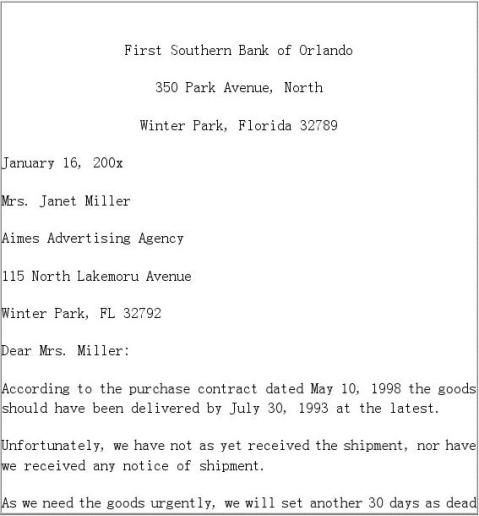
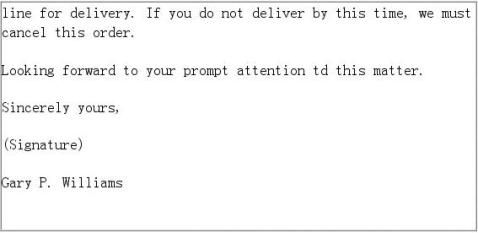
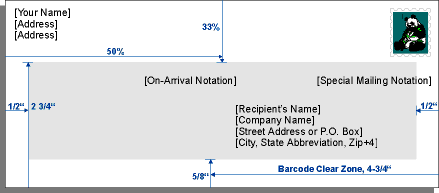
Answer: Modified block style
Business Letter Envelope Components

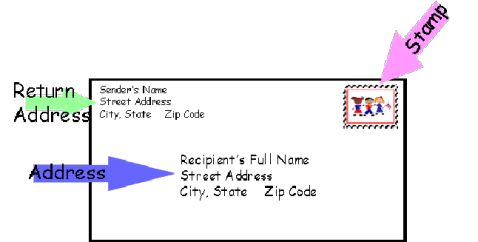
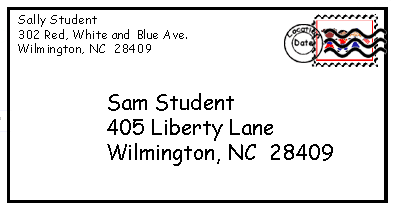
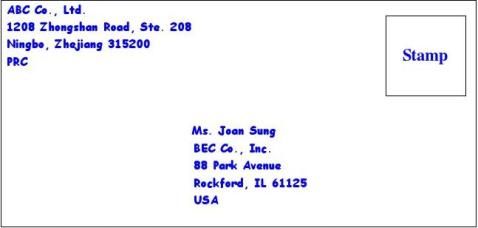
Sample Business Letters
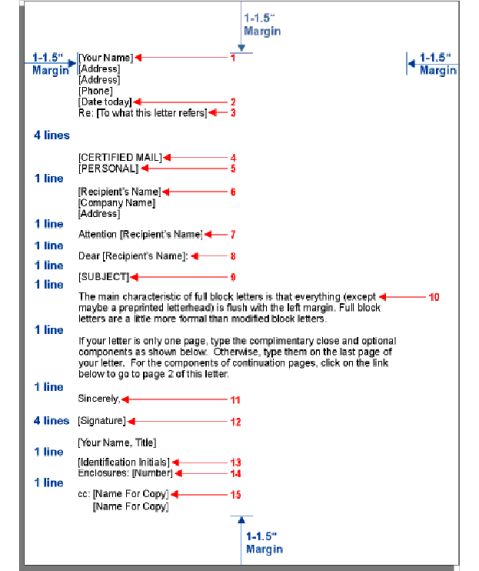
Full Block Business Letter Components
Modified Block Style Business Letter Components
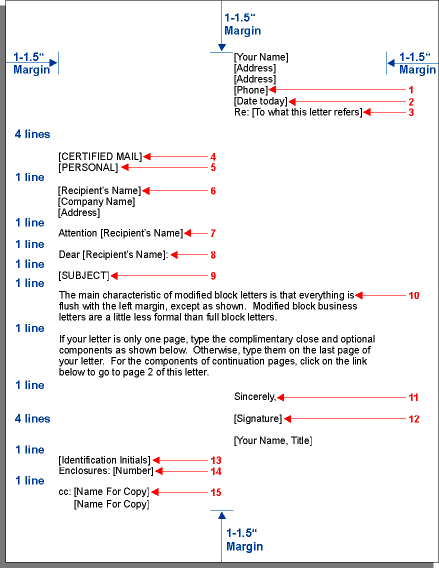
Modified Semi-Block Style Business Letter
Components
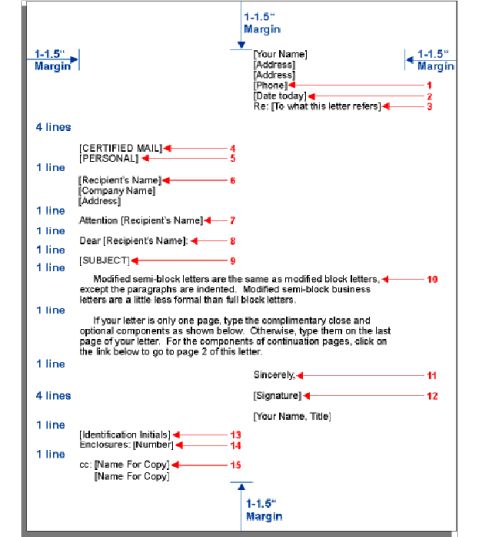
Legend:
1. Return Address: If your stationery has a letterhead, skip this. Otherwise, type your name, address and optionally, phone number, five spaces to the right
of center or flush with the right margin. Five spaces to the right of center is common. These days, it's also common to include an email address.
2. Date: Type the date five spaces to the right of center or flush with the right
margin, two to six lines below the letterhead. Five spaces to the right of center and three lines below the letterhead are common. If there is no letterhead, type it where shown.
3. Reference Line: If the recipient specifically requests information, such as a
job reference or invoice number, type it on one or two lines, immediately below and aligned with the Date (2). If you're replying to a letter, refer to it here. For example,
?
?
4. Re: Job # 625-01 Re: Your letter dated 1/1/200x. Special Mailing Notations: Type in all uppercase characters, if appropriate.
Examples include
?
?
?
5. SPECIAL DELIVERY CERTIFIED MAIL AIRMAIL On-Arrival Notations: Type in all uppercase characters, if appropriate. You
might want to include a notation on private correspondence, such as a . Include the same on the . Examples are
?
?
6. PERSONAL CONFIDENTIAL Inside Address: Type the name and address of the person and/or
company to whom you're sending the letter, three to eight lines below the last component you typed. Four lines are standard. If you type an Attention Line
(7), skip the person's name here. Do the same on the .
7. Attention Line: Type the name of the person to whom you're sending the
letter. If you type the person's name in the Inside Address (6), skip this. Do the same on the .
8. Salutation: Type the recipient's name here. Type Mr. or Ms. [Last Name] to
show respect, but don't guess spelling or gender. Some common salutations are ? Ladies:
?
?
?
?
?
9. Gentlemen: Dear Sir: Dear Sir or Madam: Dear [Full Name]: To Whom it May Concern: Subject Line: Type the gist of your letter in all uppercase characters. Be
concise on one line. If you type a Reference Line (3), consider if you really need this line. While it's not really necessary for most employment-related letters, examples are below.
?
?
?
10. SUBJECT: RESIGNATION LETTER OF REFERENCE JOB INQUIRY Body: Indent the first sentence in paragraphs five spaces. Type two spaces
between sentences. Keep it brief and to the point.
11. Complimentary Close: Type this aligned with the Date (2). What you type
here depends on the tone and degree of formality. For example,
?
?
?
?
12. Respectfully yours (very formal) Sincerely (typical, less formal) Very truly yours (polite, neutral) Cordially yours (friendly, informal) Signature Block: Align this block with the Complimentary Close (11).
Leave four blank lines to sign your name. Sign it exactly the same as you typed it below your signature. Title is optional depending on relevancy and degree of formality. Examples are
?
?
?
13. John Doe, Manager P. Smith Director, Technical Support R. T. Jones - Sr. Field Engineer Identification Initials: If someone typed the letter for you, he or she
would typically include three of your initials in all uppercase characters, then two of his or hers in all lowercase characters. If you typed your own letter, just skip it since your name is already in the Signature Block (12). Common styles are below.
? JAD/cm
?
?
14. JAD:cm clm Enclosure Notation: This line tells the reader to look in the for
more. Type the singular for only one enclosure, plural for more. If you don't enclose anything, skip it. Common styles are below.
?
?
?
15. Enclosure Enclosures: 3 Enclosures (3) cc: Stands for courtesy copies (formerly carbon copies). List the names
of people to whom you distribute copies, in alphabetical order. If addresses would be useful to the recipient of the letter, include them. If you don't copy your letter to anyone, skip it.
Assignment:
You have received a letter from Johnson Co., inquiring about your latest model of DVDs. You have decided to answer the letter immediately.
1. You have sufficient stock to meet the customers’ needs;
2. You have a wide range of goods to meet the customers’
specifications and recommend some similar new products;
3. You agree to use confirmed irrevocable letter of credit (L/C);
4. You promise to send some samples by express.
To: Ms. Alison Freeman,
Marketing Manager, Johnson Co.
11 East Shore Drive
Green Bay, WI 53405
USA
